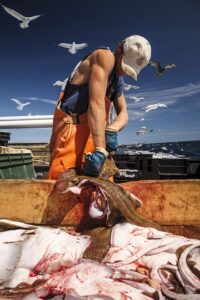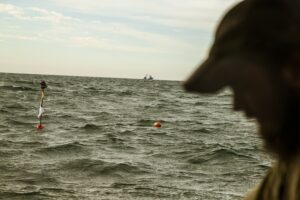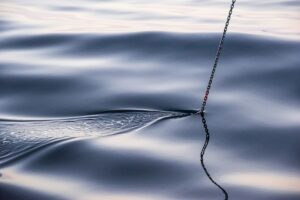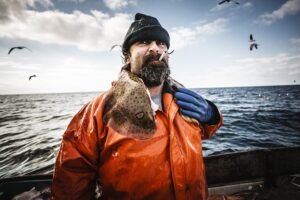Before David Hills began following fishermen, he rarely saw the sea. Born in Iowa City, Iowa, Hills grew up in Houston, where his father, Kent, was a physicist working on the Apollo Project, which sent the first humans to the Moon in 1969. His earthbound life in Texas was “flat and hot,” he says.
But the city introduced him to another means of escape. Hills’s father worked at Rice University, which had a darkroom. When Gerald Ford, campaigning for president, came to Houston in 1976, Hills went to the rally and took pictures with a little 110 camera, using black-and-white film.
“I remember the excitement of taking the pictures,” he says. Back in the darkroom, “I was so wound up, I couldn’t wait for the negatives to dry all the way.” He scratched the negatives and made prints. “It was just magical to see the print forming in the developer tray,” he says.
Hills has made a living as a commercial photographer since he was 30. He moved to Orleans with his family in 2019.
On the white walls of the newly opened David Hills Gallery in Orleans are photographs from “a watery world,” Hills says. It’s characterized by the slippery, bloody decks of fishing boats, the routines of fishermen, the motion of a gentle sea, and the dark, indifferent danger of rough water.
In 2006, Hills first ventured onto an acquaintance’s commercial fishing boat off the coast of Alaska, intrigued by the creative possibilities of photography at sea. He says the experience blew his mind.
“It turned upside-down the stereotypes about commercial fishermen,” he says. “These are not a bunch of drunken, rapacious pirates wandering around.” Most everyone he met, he says, was multi-talented. “They’ve got to be able to read the weather and fix boats. They’ve got to be able to be lawyers, figure out the regulations.”
On top of all of that, says Hills, the fishermen actually have to fish. “It’s hard enough to go out and catch a fish, let alone 10,000 pounds of fish,” he says.
Since then, Hills says, he’s connected with fishermen all over the country and taken photographs on boats fishing off every coast. The photos in his gallery document those years.
Blue gloves and yellow lines, white spray and orange skies, silver and black and the pale pink and bright red of blood and guts — the gallery seems to vibrate with color. Hills captures the unearthly stillness of a calm day at sea with the same precision as he does the muscular, golden-haired arm of a fisherman dressing skate, seagulls wheeling in the background. The man is contorted, tense, almost as if he’s dancing. That photograph is called Winging It.

In North End, taken while fishing for black sea bass in Nantucket Sound, the horizon line tilts. The effect is profoundly disorienting. To take the picture, Hills kept the camera level with the deck of the boat. “I’m trying to show that there’s an instability to this environment,” he says. “So much of what I see out there would translate better if they were moving pictures.”

Much of Hills’s work does not include people. One image, Stability, shows a chain going into the water. It’s attached to a stabilizing weight called a “bird,” used on both sides of some boats to reduce roll, though in the photo the “bird” is not visible. Instead, the chain descends, perfectly straight, until it dissolves into disturbance under soft-looking water.

At sea, enclosed in fog, sometimes “it seems like you’re nowhere,” says Hills. But on clear days, “you can home in on something as mundane and yet as limpid and lovely as this scene.”
Whether or not his photographs, taken with digital cameras, are big-A Art is a question Hills has considered. But he has a cousin, Geoff Allen, who is “an honest-to-god artist,” painting plein air in Southern California. “Anything that he touches, he turns into art,” says Hills. Once, Allen asked him what it felt like to produce his art. Hills says that the question provided answer enough for him.
One of Hills’s favorite pictures in the gallery appears as abstract: a piece called Jacob and Joshua, which Hills says is “just a rusty piece of steel and a couple of orange poly balls with some blue sky behind.” To the unassuming viewer, it’s a study of form and color, dimension and size unclear and strangely irrelevant. Hills took the picture on a lobster boat in Maine. He feels it’s one that’s “solidly pegged in the art hole.”

There’s an old story passed down through the Hills family: that one of their ancestors was a mariner from Connecticut, a sea captain who moved to Iowa to ensure that none of his sons would follow the sea and meet their ends there.
Hills doesn’t exactly follow the sea, he says. “But I’m enchanted by it, and I do try to spend as much time on it as I can.” He’s taken up fishing part-time in recent years — “I’ve pulled on ropes, I’ve picked bluefish from the strike net,” he says. “I’ve banded lobsters, I’ve dumped black sea bass out of pots, and I’ve worked the fish weirs in Nantucket Sound a few seasons.”
In his gallery, Hills says he named every photo except one: Skate Necklace. It got its title from its subject, a fisherman from Orleans named John Kelley with whom Hills went gillnet fishing in February 2012. After shooting on the boat, Hills sent Kelley a gallery of photos to choose from. Kelley sent one back — a portrait of himself in a glossy orange jacket, a hat pulled low over his forehead, a cigarette held jauntily in his mouth, a flap of dead skate around his neck — and wrote, “Skate necklace. It is boss.”

Much of commercial fishing is repetition, says Hills. That’s often how he plans his pictures: a lobsterman will haul 300 traps, and Hills will capture one that stands out. But Skate Necklace is different from those, he says. It was a spontaneous shot of Kelley, inseparably romantic and messy.
On that trip, the boat had set off at 10 p.m. Kelley, last to arrive, must have assumed Hills — a stranger, then, already onboard — was a mandatory federal observer, says Hills. Kelley had a “less than charitable outlook toward my presence on the boat,” he says. But in the morning, Kelley, cutting skates in the pale light, saw Hills with his weather gear — his “skins” — on. For a moment, despite the cold, Kelley looked warm, and Hills got the shot.
“I was down on the deck, on my hands and knees, in the slime, shooting low angle,” says Hills. “I think he began to get the picture.”



